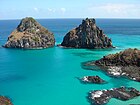Cliff-top dune: Difference between revisions
Appearance
Content deleted Content added
m Dated {{One source}}. (Build J2) |
Citation bot (talk | contribs) Add: s2cid, issue. | Use this bot. Report bugs. | Suggested by Whoop whoop pull up | #UCB_webform 12/1074 |
||
| (8 intermediate revisions by 7 users not shown) | |||
| Line 1: | Line 1: | ||
{{short description|Dune that occurs on the top of a cliff}} |
|||
{{One source|date=March 2012}} |
{{One source|date=March 2012}} |
||
'''Cliff-top dunes''', also known as '''perched dunes''', are [[dune]]s that occur on the tops of [[cliff]]s. They are uncommon in most parts of the world, because they only develop under unusual geomorphological conditions. Processes by which they may be formed include: |
'''Cliff-top dunes''', also known as '''perched dunes''', are [[dune]]s that occur on the tops of [[cliff]]s. They are uncommon in most parts of the world, because they only develop under unusual geomorphological conditions. Processes by which they may be formed include: |
||
* a dune advances up a pre-existing slope, which is then eroded to form a cliff; |
* a dune advances up a pre-existing slope, which is then eroded to form a cliff; |
||
* a dune forms during a period of high sea level, then sea level drops, exposing a cliff face. |
* a dune forms during a period of high sea level, then sea level drops, exposing a cliff face. |
||
They are most often seen as coastal landforms, but can also occur along lakes and rivers, and in deserts. Places where they are relatively common include the west |
They are most often seen as coastal landforms, but can also occur along lakes and rivers, and in deserts. Places where they are relatively common include the west coast of [[Jutland]], [[Denmark]]. They can also be found in certain places along the shores of the [[Great Lakes]] in [[Michigan]], including the Grand Sable Dunes in [[Pictured Rocks National Lakeshore]] and in the [[Sleeping Bear Dunes National Lakeshore]], most dramatically on [[South Manitou Island]]. |
||
==References== |
==References== |
||
* {{cite journal | author = Saye, Samantha E. |
* {{cite journal | author = Saye, Samantha E. | author2 = Kenneth Pye | author3 = Lars B. Clemmensen | name-list-style = amp | title = Development of a cliff-top dune indicated by particle size and geochemical characteristics: Rubjerg Knude, Denmark | journal = Sedimentology | year = 2006 | volume = 53 | issue = 1 | pages = 1–21 | doi = 10.1111/j.1365-3091.2005.00749.x|bibcode = 2006Sedim..53....1S | s2cid = 129847114 }} |
||
| Line 14: | Line 15: | ||
[[Category:Coastal geography]] |
[[Category:Coastal geography]] |
||
[[Category:Coastal and oceanic landforms]] |
[[Category:Coastal and oceanic landforms]] |
||
[[Category:Dunes]] |
|||
[[fr:Dune perchée]] |
|||
Latest revision as of 23:52, 14 August 2023
This article relies largely or entirely on a single source. (March 2012) |
Cliff-top dunes, also known as perched dunes, are dunes that occur on the tops of cliffs. They are uncommon in most parts of the world, because they only develop under unusual geomorphological conditions. Processes by which they may be formed include:
- a dune advances up a pre-existing slope, which is then eroded to form a cliff;
- a dune forms during a period of high sea level, then sea level drops, exposing a cliff face.
They are most often seen as coastal landforms, but can also occur along lakes and rivers, and in deserts. Places where they are relatively common include the west coast of Jutland, Denmark. They can also be found in certain places along the shores of the Great Lakes in Michigan, including the Grand Sable Dunes in Pictured Rocks National Lakeshore and in the Sleeping Bear Dunes National Lakeshore, most dramatically on South Manitou Island.
References
[edit]- Saye, Samantha E.; Kenneth Pye & Lars B. Clemmensen (2006). "Development of a cliff-top dune indicated by particle size and geochemical characteristics: Rubjerg Knude, Denmark". Sedimentology. 53 (1): 1–21. Bibcode:2006Sedim..53....1S. doi:10.1111/j.1365-3091.2005.00749.x. S2CID 129847114.


